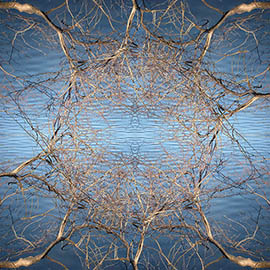
March, 2012
I photographed the nature images for this series at a pond in Redding, Conn., that once belonged to Edward Steichen. I often find inspiration there.
I reworked the images of branches, rocks, and water into kaleidoscopic impressions that speak to that inspiration. The word kaleidoscope is derived from ancient Greek, Kalos or “beautiful, beauty.” Far more than mere decoration, the symmetry of radial, repetitive patterns has always evoked a deep aesthetic, emotional, and even spiritual response from humans across cultures.
Radial symmetry design forms the organizing principle in ancient Buddhist and Hindu mandalas, which have spiritual significance. The Sanskrit word mandala means “that which encircles a center.” The Romans echo the concept in the oculus of the Pantheon, and this symmetry is also found in medieval Christian art, such as the spectacular rose windows at Chartres, Notre Dame, and Strasbourg cathedrals and the illuminations of the 12th century mystic Hildegard von Bingen. The 20th-century psychoanalyst Carl Jung saw the mandala as “a representation of the unconscious self.”
As a professor of photography, design, and pottery, I teach my students to order two- and three-dimensional space with an appreciation of this ancient understanding. I have always been drawn to a formalist approach to my image making. The visible world serves as a means to explore the language of ordered space. I find working with reflection symmetries to be immensely satisfying. The simple act of centering and finding the center is the unifying principle tying together the varied media that I teach.
Jerome Nevins
Redding, CT
Black and White Series from Summer 2000....
I set out this summer to capture the unique beauty of the places that I love. I wanted to find simple, pure images that spoke of the larger spirit of the land, the sea, and the history of these places…. letting small things define a powerful sense of place. My work this summer has been produced using a very permanent pigmented black ink and various dilutions of it in place of the standard cyan, magenta and yellow dye based and fugitive inks that come packaged with my high end inkjet printer. The fine art marketplace has coined the phrase "Giclee" to describe a fine arts approach in making prints via the highest quality inks and papers available. I am printing onto 100% cotton rag and ph buffered paper projected to last several hundred years. The resulting prints exhibit a beauty not possible to obtain with commercially available photographic materials. My larger, horizontal prints are the result of handstiching multiple frames together using Adobe Photoshop 5.5. A light overspray of Damar Varnish ensures the longest possible life for the print.
Prints measure 11"x30", 16"x20" and 11"x14"
Jerry Nevins, MFA, Still Photography, Rochester Institute of Technology
Professor, Visual and Performing Arts Department Albertus Magnus College New Haven, CT
Topstone Pond 1
Redding, CT
Pigmented Ink Print
Jerome Nevins
March, 2012